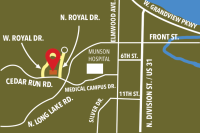Peripheral Arterial Disease
Take Care of Your Legs – Peripheral Arterial Disease
Peripheral Arterial Disease (PAD) affects more than 8 million people in the United States. African Americans, Hispanics and those over age 50 are especially at risk. It is estimated that one in every 20 Americans over 50-years-old has PAD. Baby boomers approaching the age of 50 need to be aware of their vascular health and the associated diseases, including PAD.
It is sometime difficult to know when you have PAD because typically there are no symptoms in the early stage of the disease. As the disease develops, those affected may experience discomfort or pain in their legs when they walk, but experience no pain when they rest.
Because of the lack of symptoms, it is very important to talk to your primary care physician about PAD and ask for an examination if you:
- Are 50-years-old or older, particularly males
- Experience hypertension (high blood pressure)
- Have diabetes
- Smoke
- Have high cholesterol
- Are obese
- Do not exercise
- Have a family history of vascular problems
Healthy peripheral arteries are smooth and unobstructed, allowing blood flow freely to the legs and provide oxygen, glucose, and other nutrients to the legs. With age, the peripheral arteries build up plaque, a sticky substance made up mostly of fat and cholesterol. Plaque narrows the passageway within the arteries and causes them to become stiff.
PAD results when peripheral arteries become too narrow or obstructed and limit the blood flow to the legs. If left untreated, PAD can cause pain or aching in the legs, difficulty with walking, resting pain in the foot at night in bed, non-healing sores or infections in the toes or feet, and can lead to limb loss in its most severe form.
In addition these serious arterial conditions, those with PAD should understand that people with the disease may be more likely to suffer heart attacks and stroke. The diagnosis of PAD can be established, and its severity confirmed by a simple, noninvasive Doppler examination performed onsite at the Vascular Center of Northern Michigan’s lab suite. Depending on the severity of the condition, treatment options may include lifestyle changes, medications, minimally invasive angioplasty/stenting, or open bypass surgery.


